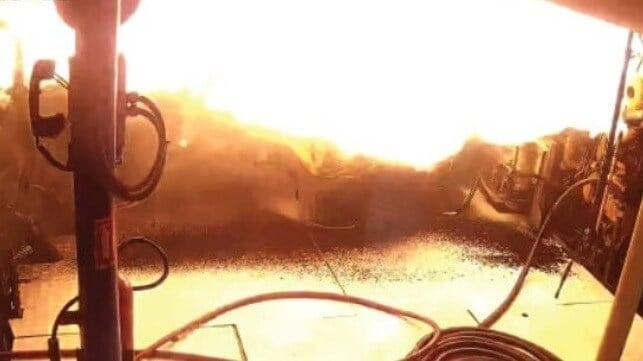NTSB: Confusion Over Fixed Firefighting System Added to Towboat Damage

A serious engine room fire aboard the towboat Capt. Kirby Dupuis escalated because the crew did not know how to activate its fixed firefighting system, according to the NTSB.
On November 9, 2021, the towing vessel Capt. Kirby Dupuis was pushing thirteen barges upbound on the Ohio River near Belleview, Kentucky. At about 0708, the master saw a flash of light on the video monitor for the engine room, and the fire alarm sounded. The captain activated the general alarm and told the crew to begin firefighting.
The "deckineer" - a deckhand who had not yet qualified as an engineer but was performing the vessel's engine-room duties - tried to enter the space to fight the fire, but was turned back by heat and smoke. He tried to start the firepump using a remote switch, but it did not work, likely due to fire damage to the electrical switchboard. He requested and received permission to activate the towboat's Novec 1230 fixed firefighting system to put out the blaze.
Following procedure, he activated remote fuel shutoffs, secured engine room hatches and ventilation, and pulled one of the two remote activation levers for the Novec fire suppression system. The fire did not go out, and he did not hear any activation sirens for the fixed firefighting system (a built-in safety feature). After spraying a number of fire extinguishers into the space and seeing the flames growing, he pulled the second of the two levers, and he believed that the firefighting system operated properly to put out the blaze after the second pull.
The vessel was evacuated by other nearby towboats, which provided boundary cooling until a fireboat arrived at 0900. The fire was out by 1300, with assistance from multiple fire departments.
The fire burned through the upper and lower engine room, causing an estimated $1.8 million in damage. A post-accident review of the engine room video determined that the source of the fire was a spray of lubricating oil from the port main engine. A service manager from the engine OEM inspected the engine and found a broken o-ring, located just below a joint on a lube oil supply tube. The tube's retaining ring was missing, along with the supporting clips and mounting hardware to hold the tube in place. The manager concluded that a pressurized spray of lube oil had hit the exhaust manifold and ignited, then the air duct above the engine had blown the fire horizontally across the compartment.
The cause for the missing mounting hardware was not determined, but a fleetwide inspection found that 10 percent of similar engines needed attention and correction.
Marine inspectors who examined the vessel after the accident found that the fixed firefighting system had never activated. Two pull levers needed to be pulled in order to set the system in action; the deckineer had pulled one, resulting in no effect, and had then returned later and pulled the other one part way. The extinguishing fluid and propellant remained in their cylinders. A technical test of the system determined that it functioned as designed.

that matters most
Get the latest maritime news delivered to your inbox daily.
The NTSB found that though the operating company had a thorough SMS and conducted extensive onboard training, its drills did not include familiarization with the fixed firefighting system. The operator is introducing a training module to cover this area.
"During interviews, the deckineer did not display a confident understanding of the overall operation of the system. Had the crew been more familiar with the system, and activated it properly, the system would have shut down the engines and ventilation fans before a complete release of both cylinders of suppression fluid into the engine room and may have quickly extinguished the fire," concluded NTSB.
